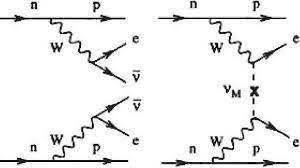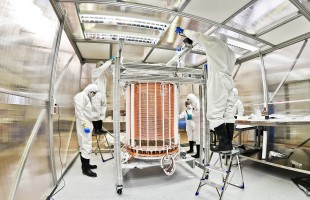The underground XENON experiment in Gran Sasso, Italy, can not only capture dark matter, but is also suitable for studying the deeper nature of neutrinos. That’s the conclusions of a new study just published in Physical Review C.
“We are now adding a full-fledged second research topic to the menu of XENON,” says Nikhef researcher Patrick Decowski (UvA), one of the lead authors of the new paper. “The neutrino sector is one of the most puzzling in the Standard Model of particle physics. It’s great if we can get a view of that.”
Expanded volume
Nikhef plays a significant role in the XENON experiment, which has been further expanded in recent years to include a five times larger volume of liquid xenon gas.
XENON is a detector deep under the mountains near L’Aquila in northern Italy, where a barrel of liquid xenon gas is used to wait for particles of dark matter from space to hit an atom and cause a signal in the device. However, the barrel of xenon also very occasionally produces signals associated with the decay of xenon to tellurium.
The natural decay of xenon is very rare, but for tracking incoming dark matter, it is important to know exactly how often it occurs. In 2019, a half-life of at least 18 billion trillion years was measured in XENON. That is extremely rare, but not zero.
Slightly adjusted
The new study adjusts that number slightly to 11 billion trillion years, but with much harder statistics of 7 sigma. In physics, 5 sigma is proof that a measurement cannot be a coincidence.
XENON was and is thus already one of the least radioactive volumes on Earth and perhaps the entire Milky Way, says Decowski. “The fact that we can measure that means we can start looking at processes that have been drowned out by background until now.”
The main target is a process called in physics the neutrinoless double-beta decay of xenon, in which two neutrons in the nucleus happen to decay simultaneously into protons and electrons. Normal beta decay releases an anti-neutrino in addition to a proton and an electron.
Majorana particles

Theorists do not rule out the possibility that two of these anti-neutrinos can cancel each other out. In that case neutrinos are so-called Majorana particles: particles that are their own antiparticle.
The new study found no trace of the neutrinoless double-beta decay. However, that does provide an even sharper estimate of the likelihood of that process. The outcome is hopeful, says Decowski. “With our larger detector and certainly with even larger projects in the future, we will get a view of the neutrinoless double-beta decay, if it is there.”
If neutrinos can be shown to be majorana particles, theorists will have much more guidance in describing neutrinos in the standard model. That would make it easier to understand, for example, why they are virtually massless and also why the universe is dominated by matter instead of antimatter.
